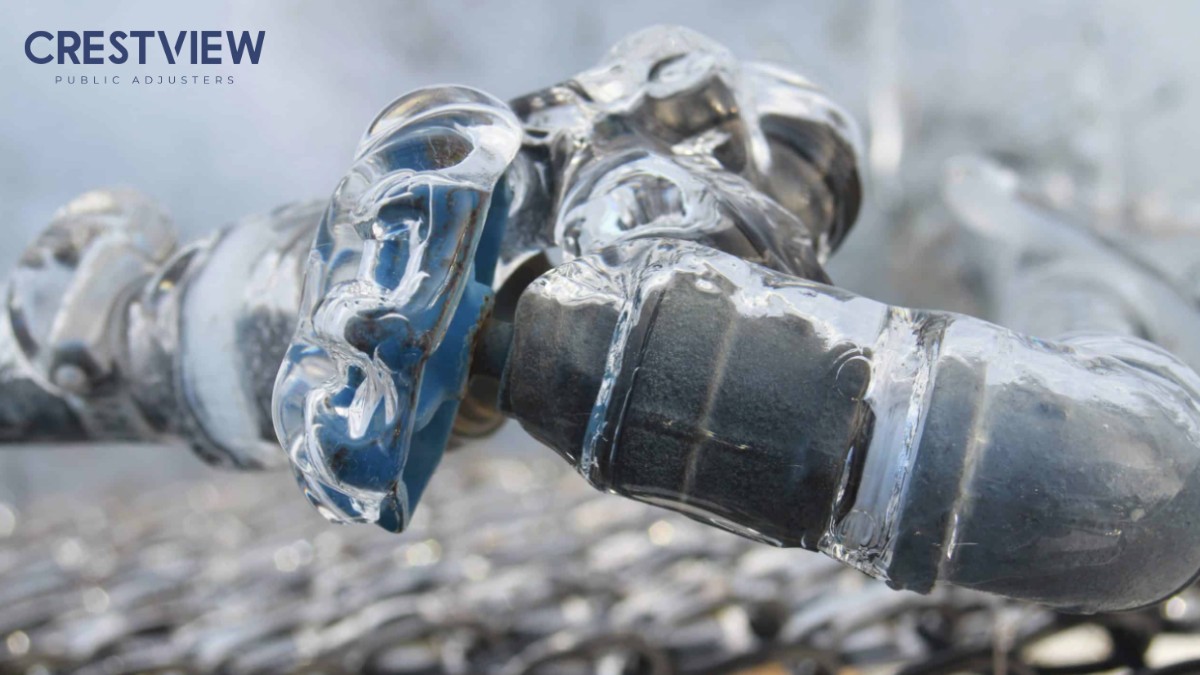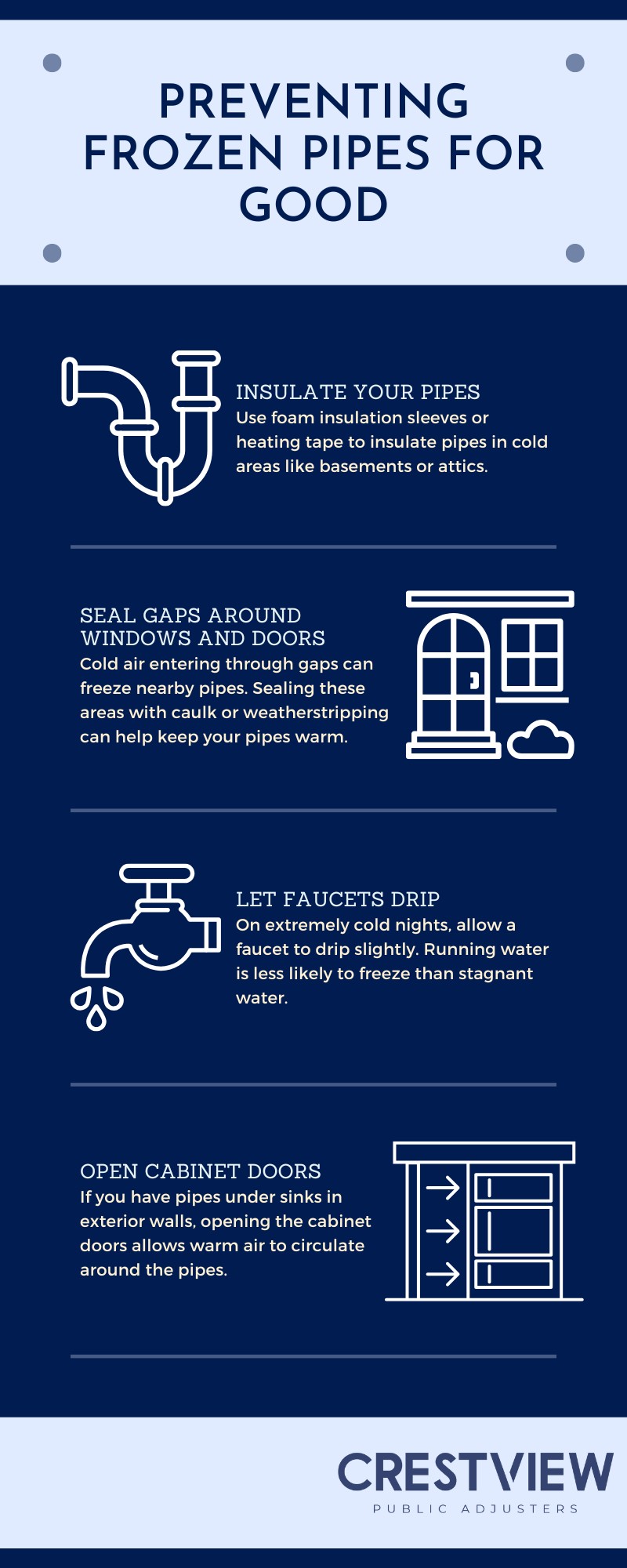Key Points:
- Frozen pipes are a common winter hazard that can cause significant damage if not addressed quickly.
- Thawing frozen pipes requires careful steps to avoid further damage and ensure safety.
- Understanding when to call a professional can save you time, money, and hassle.
Frozen pipes are a major concern for homeowners, especially during the colder months. According to the Insurance Institute for Business & Home Safety (IBHS), water damage from frozen pipes causes millions of dollars in insurance claims every year. Frozen pipes are not just a nuisance—they can lead to burst pipes, flooding, and costly repairs. If you’re dealing with frozen pipes, knowing how to thaw them correctly can prevent further issues.
What is a Frozen Pipe and Why Does it Happen?
Frozen pipes occur when the water inside the pipes reaches a temperature below freezing (32°F or 0°C). The water expands as it freezes, creating pressure within the pipe. This pressure can cause the pipe to crack or burst, resulting in water damage when it thaws. Typically, pipes in uninsulated areas like basements, attics, or exterior walls are more prone to freezing.
Key Signs of a Frozen Pipe
If you think a pipe might be frozen, the initial step is to recognize the symptoms. Here are some indicators to look out for:
- Reduced water flow: A sudden drop in water pressure or a complete lack of water when you turn on a faucet can be a clear indicator that a pipe is frozen.
- Frost on pipes: If you notice frost or condensation on exposed pipes, they might be frozen.
- Strange odors: Sometimes, frozen pipes that have been blocked for a while can produce unpleasant smells when the water backs up.
Understanding these symptoms is key to acting quickly and preventing further damage.
How to Thaw a Frozen Pipe: Step-by-Step Guide
Upon discovering a frozen pipe, quick action is crucial to avoid a burst pipe. The following steps outline how to thaw a frozen pipe safely.
1. Locate the Frozen Pipe
First, you need to pinpoint where the pipe is frozen. Start by checking faucets that aren’t working and trace the pipes leading to them. Most frozen pipes are found in areas with poor insulation, such as basements, crawlspaces, attics, and exterior walls.
If the pipe is accessible, proceed with the next steps. If the pipe is hidden, you may need to contact a plumber for professional help.
2. Shut Off the Water Supply
Before attempting any thawing methods, it’s important to turn off the main water supply to the house. This will prevent water from flooding the home if the pipe bursts during the thawing process.
3. Start Thawing the Pipe
Once the water supply is off, you can begin thawing the frozen pipe. There are a few methods to do this, and it’s important to choose the safest one for your situation.
Use a Hairdryer or Heat Gun
If the frozen section of pipe is accessible, using a hairdryer or heat gun is one of the safest ways to thaw the pipe. Start at the end of the pipe closest to the faucet and work your way back. Never use an open flame to thaw a pipe—this can cause a fire hazard.
Apply Heating Pads or Towels
If you don’t have a hairdryer, another option is to apply heating pads or warm towels to the frozen area. Soak towels in warm water, wring them out, and wrap them around the frozen pipe. This method can be slow but effective.
Use a Space Heater
If the frozen section is located in an enclosed area, like a crawlspace, placing a space heater in the room may help thaw the pipe. Keep the heater at a safe distance from any flammable materials, and never leave it unattended.

Use a Pipe Thawing Machine
For more stubborn ice blockages, a pipe thawing machine might be necessary. This professional tool can safely heat the pipe and melt the ice inside. If you don’t have one, you may need to contact a plumber or a professional thawing service.
4. Check for Leaks After Thawing
Once the pipe has thawed, check for any visible cracks or leaks. If you find any, it’s crucial to address the damage right away to prevent further water damage. In case of serious leaks or pipe bursts, it’s best to call a professional plumber to repair the pipe.
What Are the Risks of Thawing a Frozen Pipe?
While thawing frozen pipes may seem straightforward, there are risks involved. If done incorrectly, you could inadvertently cause more damage. Here are some risks to consider:
- Bursting the pipe: Rapid thawing can cause the water inside to expand quickly, potentially causing a burst pipe. Always heat the pipe slowly and evenly to reduce this risk.
- Fire hazards: Using heat sources like open flames or electrical appliances can pose fire risks. Always follow safety precautions when using space heaters, hairdryers, or other heating devices.
- Electrical shock: If using electric appliances near water or damp areas, there is a risk of electrical shock. Be cautious and ensure all equipment is properly grounded.
How to Prevent Frozen Pipes in the Future
Thawing a frozen pipe is one thing, but preventing them in the first place is even more important. Taking steps to insulate and protect your pipes can save you from headaches later. Here’s how to prevent frozen pipes:

When Should You Call a Professional to Thaw Frozen Pipes?
While many homeowners can handle the task of thawing frozen pipes themselves, some situations require professional help. Here’s when you should call a plumber or a professional:
- If you can’t locate the frozen pipe or it’s hidden within a wall or ceiling.
- If you suspect a pipe has already burst or is leaking.
- If you’re unsure about using the proper equipment safely.
- If the frozen pipe is in a hard-to-reach area, like under concrete floors or in the foundation.
If in doubt, contacting a professional can save you time, money, and prevent further damage.
Get Help from a Public Adjuster
If your frozen pipes have caused significant damage, it may be time to file a claim. At Crestview, we specialize in public adjusting for frozen pipe claims in New York, New Jersey, and Florida. Our team is here to help you navigate the complexities of the claims process and ensure you receive the compensation you deserve.
Call Crestview today for expert help with your frozen pipe claim!

